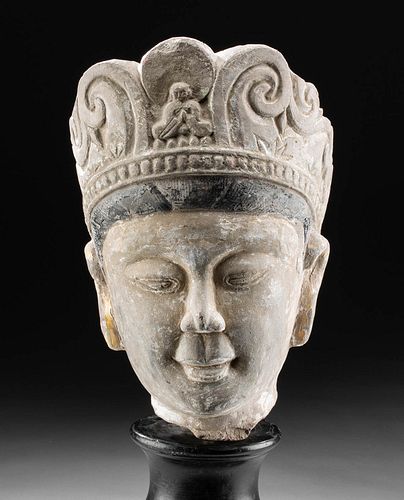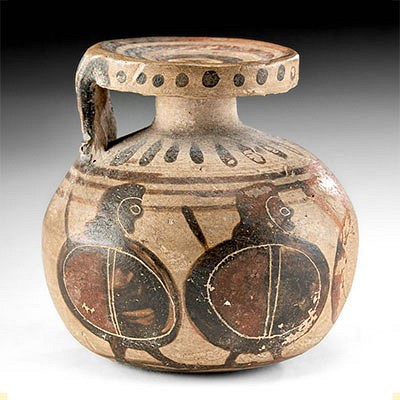Chinese Ming Dynasty Stucco Head of Bodhisattva
Lot 49
About Seller
Artemis Fine Arts
686 S Taylor Ave, Ste 106
Louisville, CO 80027
United States
Selling antiquities, ancient and ethnographic art online since 1993, Artemis Gallery specializes in Classical Antiquities (Egyptian, Greek, Roman, Near Eastern), Asian, Pre-Columbian, African / Tribal / Oceanographic art. Our extensive inventory includes pottery, stone, metal, wood, glass and textil...Read more
Categories
Estimate:
$2,800 - $3,500
Absentee vs Live bid
Two ways to bid:
- Leave a max absentee bid and the platform will bid on your behalf up to your maximum bid during the live auction.
- Bid live during the auction and your bids will be submitted real-time to the auctioneer.
Bid Increments
| Price | Bid Increment |
|---|---|
| $0 | $25 |
| $300 | $50 |
| $1,000 | $100 |
| $2,000 | $250 |
| $5,000 | $500 |
| $10,000 | $1,000 |
| $20,000 | $2,500 |
| $50,000 | $5,000 |
| $100,000 | $10,000 |
| $200,000 | $20,000 |
About Auction
By Artemis Fine Arts
Jan 7, 2021
Set Reminder
2021-01-07 10:00:00
2021-01-07 10:00:00
America/New_York
Bidsquare
Bidsquare : Ancient / Ethnographic Art Through The Ages
https://www.bidsquare.com/auctions/artemis-gallery/ancient-ethnographic-art-through-the-ages-6258
Ancient art from Egypt, Greece, Italy and the Near East, as well as Asian, Fossils, Pre-Columbian, Native American, African / Tribal / Oceanic, Fine art, and much more! All categories, all price ranges... all legally acquired and guaranteed to be as described or your money back. Artemis Fine Arts info@artemisgallery.com
Ancient art from Egypt, Greece, Italy and the Near East, as well as Asian, Fossils, Pre-Columbian, Native American, African / Tribal / Oceanic, Fine art, and much more! All categories, all price ranges... all legally acquired and guaranteed to be as described or your money back. Artemis Fine Arts info@artemisgallery.com
- Lot Description
East Asia, China, Ming Dynasty, ca. 1368 to 1644 CE. A striking stucco head depicting a bodhisattva donning an elaborate crown adorned with a central Buddha who is flanked by spiraling tendrils with a lovely beaded band (perhaps with pearls) below. Her beautiful face is finely modeled with elegant facial planes, slightly pursed lips, a philtrum above, somewhat downcast eyes, arched brows leading to an aquiline nose, long earlobes, and a fringe of black hair that is further embellished with finely incised lobes and drawn back beneath her crown. The head is further embellished with traces of yellow and red pigment on the ears as well as white and yellow pigment on the face and headdress, and black and red pigment on the coiffure. Size: 7.5" L x 7.375" W x 12.375" H (19 cm x 18.7 cm x 31.4 cm); 16.875" H (42.9 cm) on included custom stand.
Bodhisattvas are among the most compassionate beings in the universe, devoting themselves to saving the suffering and helping others achieve enlightenment and Buddhahood. Traditionally depicted as less austere than Buddhas with graceful postures and elegant garments, a nod to the riches of the Northwestern Chinese Silk Road, this piece is no exception. Bodhisattvas or Guanyin are associated with compassion and mercy - their long ears significant, because they rescues all human beings by hearing their cries for help and the sounds of suffering.
Provenance: private Los Angeles, California, USA collection, purchased between the 1980s to 2000s; originally purchased from London art market, later placed in London auction sale
All items legal to buy/sell under U.S. Statute covering cultural patrimony Code 2600, CHAPTER 14, and are guaranteed to be as described or your money back.
A Certificate of Authenticity will accompany all winning bids.
We ship worldwide and handle all shipping in-house for your convenience.
#153970A fragment from a larger statue with losses to the neckline, peripheries of the headdress and high-pointed areas. Fissures on verso, possibly indicative of repairs, but may simply be stabilized fissures. Concave area on verso of headdress is rough as if it once had attached elements. Expected surface wear commensurate with age. Ample black pigment adorning hair and traces of red, yellow, and white pigment on the head and headdress as described.Condition
- Shipping Info
-
All shipping is handled in-house for your convenience. Your invoice from Artemis Gallery will include shipping calculation instructions. If in doubt, please inquire BEFORE bidding for estimated shipping costs for individual items.
-
- Buyer's Premium



 EUR
EUR CAD
CAD AUD
AUD GBP
GBP MXN
MXN HKD
HKD CNY
CNY MYR
MYR SEK
SEK SGD
SGD CHF
CHF THB
THB














